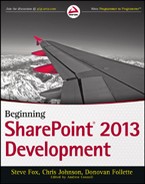Chapter 1
Introduction to SharePoint 2013
WHAT YOU WILL LEARN IN THIS CHAPTER:
- Understanding what SharePoint is
- Learning about the high-level feature areas and functionality of SharePoint 2013
- Understanding the relevance of these feature areas and functionality to the developer
SharePoint 2010 launched a major evolution in the product’s life — it was a first-class platform that enabled you to not only leverage a wide array of out-of-the-box features to manage collaboration, but it also provided a rich development platform. This made developing solutions powerful and relatively straightforward. With SharePoint 2013 arrives a new paradigm shift, one much more closely aligned to Microsoft’s overall shift to the cloud. For those of you who have been on the SharePoint train for some time, this means thinking in a slightly different way about how you develop applications for SharePoint. For those who are new to SharePoint, welcome. You’re in for one heck of a ride!
SharePoint is an exciting Web-based technology. In its fifth version, SharePoint has undergone quite a transformation from the initial releases, and the types of things you can do with SharePoint run far and wide. Those who have had the chance to see the product grow up will be surprised and happy with many of the changes that are now built into the platform. In fact, existing SharePoint developers will witness what arguably is a sea-of-change in the features and functionality that SharePoint provides, as well as an evolution in the tools supported and the developer community that rallies around the technology. Aspiring SharePoint developers will realize quite a bit of power exists in the platform and should have the capability to put it into practice by the end of this book.
SharePoint is maturing into a cloud-centric platform that will enable you to build and deploy a wide array of solutions, as well as take advantage of the build-and-publish model that SharePoint users and developers have come to enjoy. It has also evolved into a platform that is much more open by design. This means that developers are moving beyond what was predominantly an ASP.NET- or JavaScript-based development approach. In SharePoint 2013, you have the ability to bring your own hosted Web applications and technologies to the table and use OAuth authentication and registration hooks that are built into SharePoint to integrate those apps into the SharePoint experience. This is a significant evolution, and one not to be undersold.
Similar to SharePoint 2010, SharePoint 2013 offers such a wide array of features that claiming to be an expert across all the workloads will be challenging for any one person. You will need to dedicate some time to become an expert, but the journey will be worth it.
With that in mind, this chapter introduces you to what SharePoint is and walks through some of the high-level areas for the developer. This chapter also answers the question of what capabilities make SharePoint a platform that is interesting and compelling for you, the developer, to learn. It also helps you understand why SharePoint 2013 is evolving to the cloud.
Specific topics include discussion around programmability, new app models, platform services, and the ways in which you can build and deploy a SharePoint solution.
